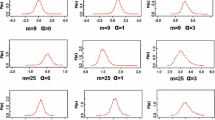Abstract
The orthogonal transformed indicator approach to conditional cumulative distribution functions is based on the decomposition of the indicator variogram matrix as a matrix product. This paper explores the manner in which the decomposition algorithm affects the conditional cumulative distribution function as estimated by orthogonal transformed indicator kriging. Five decomposition algorithms are considered: spectral, Cholesky, symmetric, Cholesky-spectral, and simultaneous decompositions. Impact of the algorithms on spatial orthogonality and order relations problems is examined and their performances together with indicator kriging are compared using a real dataset.
Similar content being viewed by others
REFERENCES
Bourgault, G., and Marcotte, D., 1991, Multivariate variogram and its application to the linear model of coregionalization: Math. Geology, v. 23, no. 7, p. 899–928.
Carr, J., 1994, Order relation correction experiments for probability kriging: Math. Geology, v. 26, no. 5, p. 605–621.
Davis, M., 1987a, Production of conditional simulations via the LU decomposition of the covariance matrix: Math. Geology, v. 19, no. 2, p. 91–98.
Davis, M., 1987b, Generating large stochastic simulations–the matrix polynomial approximation method: Math. Geology, v. 19, no. 2, p. 99–107.
De Leeuw, J., and Pruzansky, S., 1978, A new computation method to fit the weighted Euclidean distance model: Psychometrika, v. 43, no. 4, p. 479–490.
Deutsch, C. V., and Journel, A. G., 1992, GSLIB: Geostatistical software library and user's guide: Oxford University Press, New York, 340 p.
Goovaerts, P., 1993, Spatial orthogonality of the principal components computed from coregionalized variables: Math. Geology, v. 25, no. 3, p. 281–302.
Goovaerts, P., 1994, Comparative performance of indicator algorithms for modeling conditional probability distribution functions: Math. Geology, v. 26, no. 3, p. 389–411.
Goovaerts, P., 1997, Geostatistics for natural resourses evaluation: Oxford University Press, New York, 483 p.
Lajaunie, Ch., 1990, Comparing some approximate methods for building local confidence intervals for predicting regionalized variables: Math. Geology, v. 22, no. 1, p. 123–144.
Lajaunie, Ch., 1992, Comment on “indicator principal component kriging,” Math. Geology, v. 24, no. 5, p. 555-561.
Rao, C. R., 1965, Linear statistical inference and its applications: John Wiley & Sons, New York, 522 p.
Suro-Perez, V., and Journel, A. G., 1991, Indicator principal component kriging: Math. Geology, v. 23, no. 5, p. 759–788.
Suro-Perez, V., and Journel, A. G., 1992, Reply to Lajaunie's comments: Math Geology, v. 24, no. 5, p. 563–565.
Tercan, A. E., 1993, Nonparametric methods for estimating conditional distributions and local confidence intervals: Unpublished PhD dissertation, the Department of Mining and Mineral Engineering, The University of Leeds, 156 p.
Wackernagel, H., 1995, Multivariate geostatistics: An introduction with applications: Springer-Verlag, Berlin, 256 p.
Xie, T., and Myers, D. E., 1995, Fitting matrix-valued variogram models by simultaneous diagonalization, Part I: theory: Math. Geology, v. 27, no. 7, p. 867–875.
Xie, T., Myers, D. E., and Long, A. E., 1995, Fitting matrix-valued variogram models by simultaneous diagonalization, Part II: application: Math. Geology, v. 27, no. 7, p. 877–888.
Author information
Authors and Affiliations
Rights and permissions
About this article
Cite this article
Tercan, A.E. Importance of Orthogonalization Algorithm in Modeling Conditional Distributions by Orthogonal Transformed Indicator Methods. Mathematical Geology 31, 155–173 (1999). https://doi.org/10.1023/A:1007557701073
Issue Date:
DOI: https://doi.org/10.1023/A:1007557701073




